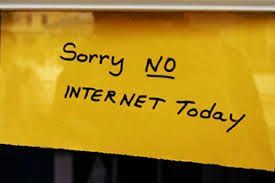
Mac Does Not Connect to the Internet
One of the more frequent issues that Mac users come across, is a problem connecting to the internet. When this happens, the user will receive a message that says, “You are not connected to the Internet”. The webpages will be blank and will not open in the web browser and the internet apps such as Mail, iChat, or the App Store tend to be inaccessible as well.
One reason might simply be that the router has been configured to allow only some services to use the Internet. For example, it may allow access to your mail service, while blocking Web browsers from using the Web. If you are not sure how your network is configured, contact your network administrator. (If your network is not configured to prevent some services from using the Web, and some Internet applications work fine and others do not, then the issue is probably not related to your Wi-Fi network.)
If your computer cannot get online at all, try these suggestions:
- Make sure that Wi-Fi is on. Mac OS X has the option to turn off your Wi-Fi – AirPort card in case you do not wish to use it. Sometimes, the Wi-Fi card may be turned off accidentally. Look at the Wi-Fi menu (AirPort menu bar). It is located in the top right corner of the screen. If its interface is on and connected to a Wi-Fi network, the Wi-Fi icon will look dark. If Wi-Fi is off, choose Turn Wi-Fi On from the menu.
- If the Wi-Fi interface does not appear in System Preferences, make sure that your Wi-Fi card is recognized by your Mac. Start from the installation media that came with your Mac, or from the Recovery HD if OS X Lion is installed. Your computer should be able to access available networks. If you are still not able to get online, make sure that your computer has joined the correct Wi-Fi network (which should be listed in the Wi-Fi menu.) Select your network if it is not already chosen. If your Wi-Fi network is secured using a password, you will be prompted to enter a password. If you do not know your network password, you will need to contact the administrator of your Wi-Fi network. If you are the administrator/owner of the network, you will have to change your password on the router.
- Your Wi-Fi network may not be visible in the list. If the network is closed, it will not broadcast the network’s name. Choose Join Other Network from the Wi-Fi menu, and you will be prompted to enter the network name and security setting. Enter the name of your network and choose the Security your network uses. If your network is still not visible in your Wi-Fi network list, then it may be using an incompatible Wi-Fi standard. To check which standards your Mac supports, use Network Utility. Set the network interface to Wi-Fi and examine the information listed after Model.
- If your computer has joined the correct Wi-Fi network, but you are still unable to get online, you should check your TCP/IP settings in the Network pane of the System Preferences. Select System Preferences from the Apple menu and then choose Network from the View menu. Select Wi-Fi, click the Advanced button in the lower-left hand corner of the screen, and then select the TCP/IP tab from the top of the screen. If no IPv4 address appears, or if the IP address starts with “169.254.xxx.xxx”, click “Renew DHCP Lease”. Consult with your network administrator to determine the correct TCP/IP settings for your Wi-Fi network, because without the correct TCP/IP settings, your device will not be able to get online.
- If your TCP/IP settings are correct, but your computer still cannot access the Internet, check the DNS tab. DNS is an Internet service that translates IP addresses into URLs and vice-versa. A correct DNS configuration allows your computer to connect to www.apple.com without having to enter the specific IP address of the Apple servers. Contact your ISP for DNS addresses or use the DNS provided by a public service. To add a new DNS address, click the + button and enter the IP address for that DNS.
- Try connecting to your router through Ethernet, if your Mac has an Ethernet port available. Connect an Ethernet cable directly to your Wi-Fi router from your computer.
- Check your range to the Wi-Fi router and reduce the effect of interference. If your computer is too far from your Wi-Fi router, or your environment has too much Wi-Fi interference, then it may not detect the Wi-Fi network. The easiest way to check for range limits is to move your Mac or your Wi-Fi router closer together, and make sure that there are no obstructions between the two.
- Try connecting to a different Wi-Fi network. If your computer does not exhibit any symptoms when connected to a different Wi-Fi network, then the issue may be related to your network router or ISP. In that case, you should contact the manufacturer of your router or your ISP.
See also:
- For more information about Apple visit our iGotOffer Encyclopedia






Facebook
Twitter
RSS